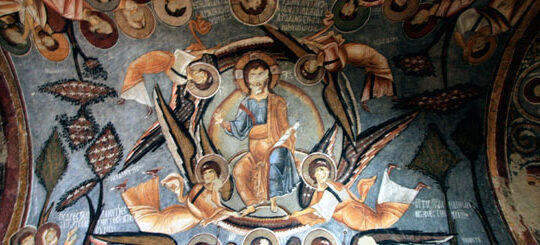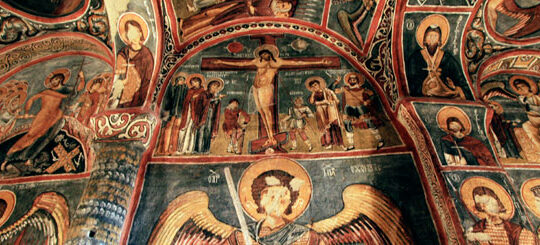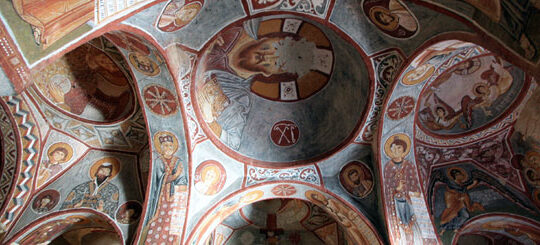Goreme was known, in the ancient times, as Korama. The first references to it are in the early 7th c Acts of St Hieron, a 3rd C. saint who was a native of Matianoi, or the modern Maccan. Goreme is an amphitheatre of ample portions surrounded by steep cliffs leading to a pleasant, verdant valley, which puzzles every single visitor, by the interesting access to many of the caves. The place we refer as the Goreme Open Air Museum is located in a small part of the whole valley, and right next door to the modern village of Goreme. It must have been such a convenient place to dwell that Goreme acted as one of the most important monastic settlements in the early Christian ages. There are over 8 cave churches in the Göreme Open Air Museum. Tokali (Buckle) Church is outside the museum, but with your ticket you can visit this church. Dark Church is the best preserved church in the museum and it has an extra entrance fee.
St. Basil’s Churc
It is on the left side of the fountain, just opposite to the entrance. Its entrance is full of graves and the paintings are of llth century. The only aisle of the chapel is rectangular, with a large apse and two small apses. Inside the central apse a portrait of Christ is visible. The paintings are on bare rock. On the northern wall the standing figure is St. Basil. Aside to him is St. Theodore, riding a horse. On the opposite wall St. George is represented slaying a snake. Figures of the Holy Virgin and infant Jesus are painted between the two apses.
Apple (Elmali) Church
This church is at the right hand side of the path leading to the centre. The original entrance was up from the valley but it is not available now. The existing narrow corridor is rather recent. Elmali church is a typical central domed church with four columns, built on a cross plan with its large and small apses. The name is given by the local people, referring to the once existing orchard nearby. The aristocrat art of the Karanlik and Carikli churches is seen in this church, too. It is quite obvious that these three churches were painted by the artists of the same school. The design of the frescoes and selection of the ornaments indicates the high quality of art. The postures of the figures are adapted to the background they are painted on. The frescoes inside the church are based on the following themes: The Baptism, Raising of the Dead, Angels at the Tomb, Last Supper, Journey to Bethlehem, Transfiguration, Ascension, and Betrayal. Head portrait of Christ is painted on the central dome. Inside the small domes are the angels. The four evangelists (John, Matthews, Mark and Luke) are painted just above the columns, inside the circles. On the arches the prophets are seen standing, each holding an inscription (Jonas, Moses, Daniel, Elias, David, Sabakkuk and Ambakon). Just above the entrance is the Nativity, of which only some parts are visible.
St. Barbara Chapel
It is a small church with two columns and a small dome. The walls are full of randomly painted decorations and Christ is painted in the central apse. On the northern wall St. George and St. Theodore are represented slaying the dragon. Besides this is the scene of Flight to Egypt. These frescoes are painted directly on the wall. Architectural details are not ignored and the purpose of the linear decoration is to give the feeling of a masonry-built church. Similar to the Barbara Church there are other XIth century churches with linear and geometric designs enriched with thick lines. They keep their mystery since nothing is written to give any explanation. Doubtlessly the birds, the strange figure between the two crosses and the spear ends are trying to represent some symbolic and magic forces that we can not appreciate at the moment.
Snake Church
The church consists of two parts; first a long nave then another section with a flat ceiling. Opposite to the entrance Christ is seen standing, with a young boy beside him. The first two figures on the upper right wall are St. Basil and St. Thomas. Then comes St. Onuphirious with a leaf covering her genital organ. According to the tale St. Onuphirious was a frivolous woman once. One day she prays God to protect her from Men. God accepts her will and uglifies her with beard and moustache and she retires into a secluded life. The first figure on the upper left wall is St. Onosimos. Further on St. Theodor and St. George are represented as slaying the snake. Following on the left side, figures of Emperor Constantine and Empress Helena are seen with a cross between them. This Orthodox cross represents the good relationships between them and Cappadocians. The paintings of the Yilanli Church belong to the llth century. The church gets its name from the painting of a snake. Cellar, Kitchen and RefectoryThese are three rooms side by side, connected with an inside passage. The first room was used as a cellar. The places to store the food are still present. The second room served as a kitchen. The pit at the centre of the room is called “Tandir” a special type of fire-place that is still popular in the villages. The third room is the refectory. At the left side of the entrance a large table and sitting places are hollowed out of the rock. There is enough place for 40-50 people. At the head of the table there is a private place for some important person to sit. Opposite the entrance is a pit for pressing the grapes. The alcoves on the walls are for storing the food.
Dark (Karanlik) Church
This church is the best example of the llth century Byzantine art. The entrance is from a narrow, turning stairway. After a small narthex comes the four columned hall of the church. It is built on a basilica plan with a central apse and two side apses, in the shape of a cross. The only source of light is a small opening in the narthex and because of this the colours remained unfaded. It is the most well-preserved church of the area. On the ceiling of the narthex. Ascension and related themes are painted. Praying of the Apostles is on the right wall. The painting on the opposite wall is about the consolation of Mary by the Apostles. To the left of the small window there is a fresco indicating the hospitality of prophet Abraham. (His wife Sarah is at the right-hand side, dressed in a light brown gown.) At the centre three angels are sitting by the table. Two saints are represented on the right side of the entrance each holding a sword. Vegetable decorations are painted above the arches and inside them we see three saints. They are three of the five saints who were killed in Persia. Inside the nave four small domes are decorated with the figures of the four angels. Christ is seen as the Pontacrator in the two large domes. The frescoes follow this order beginning from the right wall: Angels Guarding the Tomb, Crucifixion. (Four women of Galilee are “watching with grief; Mary of Kleofas, Mary of Mecdel, Joanna and Solome.) Christ arrested by the Roman soldiers. (Inside the Get-semani Gardens, in the valley of Elnar near Jerusalem. Christ is embraced by Judas; at the far left St. Peter is holding a knife in order to protect Christ but he hurts the ear of one of the servants.) The Resurrection is in the right hand corner. (Adam and Eve on the left, David and Solomon on the right.) Above the right apse we see the Last Supper. (The hand of Judas is on the table, and the names of the Apostles are, Bartholommeus, Jacobus, Andreas, Judas, Petrus, Johannes, Thomas, Young Jacobus, Phillippus, Matthaus, Thaddeus and Simon.) Christ is in the central apse. In the left-hand corner, we see the four evangelists. Nativity is on the same wall to the left. (Joseph is seen sitting, perplexed. Infant Jesus is in a cradle.) Next to it is the bathing of the child. Just above we see the Three Kings from the East with their gifts in their hands. (Their names are Gaspar, Melchior and Balthazar and they represent the three generations.) The Journey to Bethlehem is painted on the other corner. Then comes the Baptism, and Transfiguration is above the entrance.
St. Catherina Chapel
Built by a donor named Anna, the Chapel of St. Catherine dates from the 11th century. It has a Greek-cross-shaped nave, with a dome over the center and barrel-vaulted cross arms. The narthex has nine floor tombs and two burial niches. The frescoes depict: a Deesis (in the apse); Doctors of the Church: Gregory, Basil the Great and John Chrysostom; St. George, St. Theodore, and St. Catherine.
Buckle (Tokali) Church
The narthex of this church was painted during the first half of the 10th century and the other parts during the second half. With its narthex, central hall and side nave, Tokali Church is the largest of the area. Its long narthex is perpendicular to the central hall. At the east side of the hall there are four columns connected to each other with arches. Behind the arches there is an elevated corridor and after the corridor comes the central and side apses. The upper sections of the narthex are full of paintings, in chronological order, about Christ’s life. Red and green are the outstanding colours. Availability of more space in the nave provided possibility for painters to go into more details. St. Basil’s life, figures of other saints and the miracles of Christ are the themes used in the nave. The paintings in the narthex are in this order: The Annunciation, The Visitation (The visit of the Virgin Mary to Elizabeth), Ordeal by Water, Nativity, Adoration of the Magi, Massacre of the Innocents, Flight to Egypt, Meeting St. John the Baptist, The Baptism, Miracle in the Sea of Galilee, Feeding of the Five Thousand, Healing the Eyes of the Blind, Resurrection of St. Lazarus, The Last Supper, The Betrayal, Carrying the Cross, The Crucifixion, Descent From the Cross, Holy Women at the Tomb, The Second Coming and Christ with the Twelve Apostles. Probably the name of the church comes from the buckle once hanging from the ceiling. Although the buckle is gone its place can be seen.
* El Nazar Church
This church is in Zemi Valley, amongst the vineyards. It is in the shape of the letter T. The frescoes are about Christ’s life and other saints and were painted in the eleventh century. The church is partly destroyed by erosion, but it is worth seeing.
* Sakli Church (St. John)
It is on a hill on the road to Goreme. The paintings are of 11th century and they are painted directly on the rock. This is the most outstanding church in Goreme. The style and the colors are of high quality and bright. It was discovered in 1957. Thus, unlike other churches, the frescoes could remain intact. Especially the angel decorations are very beautiful. The church is located in a place where the region is best seen.




